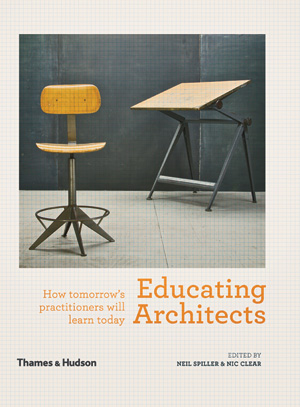This is actually three books in one. As a collection of 40 essays by 35 different authors, it is, first, an advertisement for the University of Greenwich's Department of Architecture and Landscape in its new location at the Maritime Greenwich World Heritage Site outside of London and its assumed new relevance. It is, alternatively, a platform for schools of architecture that indulge “radicality,” “innovation,” and visions of the “future.” And, finally, it is a history of various schools offering alternative (read: anti-institutional) modes of education.
The first of these is rather charming as you see Neil Spiller and Nic Clear, who edited the book and teach at Greenwich, pour their enthusiasm for a type of education—a mix of the approaches of the Architectural Association (AA), SCI-Arc, and the University of Applied Arts in Vienna—into the pedagogy of their new department. Their anticipation of bypassing leaden, myopic, and risk-averse academia is clear, even if you, as a reader, feel a bit queasy about their self-promotion. The third “book” is also enlightening. The histories of the AA, and architecture programs at UCLA, the Berlage, and Cornell, for example, though not unknown, are told here by current teachers at these schools who offer insights into the struggle to simultaneously build on and transcend institutional legacies. It is the second “book” that is troubling, since it assumes that teaching formal radicality is “how tomorrow's practitioners will learn today.” In other words, prejudice masquerades as a list of relevant schools.
The introduction by Spiller is quite inspiring, in part because of his optimism. “Architectural education is a delicate ecology, but thankfully it is in the hands of deans and directors . . . who vigorously defend its integrity . . . and students from the vicissitudes and strange economies of academia,” he writes. He also indicates that innovation won't be equated with software pyrotechnics. He says he has learned “that the world is not in thrall with parametricism, and the nagging fear that it has become a fashionable rash across the world is unfounded.” But the preponderance of chapters, pedogogies, and images celebrating unusual forms—nay, formal imagery— for their own sake belies those statements.
This may or may not be cause for dismissal. A reader could mark the inconsistency and just move on to read about how Hernan Diaz Alonso, Hani Rashid, Evan Douglis, or a host of others are pushing disciplinary boundaries. Or one could note that, tucked into the book, are outliers who have smart things to say about contemporary architectural education. For example, Ben Nicholson's short essay, “Wot got left out,” moves beyond platitudes of envisioning the future. “I mean, how in all consciousness can we design a boat house on the Thames, while half the residents of the globe live on $2 a day?” he asks. Similarly, Mark Burry describes how his Spatial Information Architecture Laboratory at RMIT inserts practitioners into education and mixes academia with industry. Mark Morris's essay on Cornell reveals that school's struggles for digital relevance and raises the issue of online courses for architecture. Nigel Coates examines the elephant in the room: the disproportion between the cost of architectural education and its marginal power. In a book preaching globalism, the editors recognize that there might be Chinese educators, so they include an essay by Kongjian Yu on Peking University.
But it is depressing to read that future-oriented pedagogy looks so much like the past. Yes, the architectural forms in the book are different from those we saw 40 years ago, but the paradigms have barely budged. Here, the AA under Alvin Boyarsky is still the model. The Archigrammy “just play” rhetoric of Peter Cook at the Bartlett still excites. The imperative to create “sublime architectures that are personal” is still a means to usher in the future. It is so yesterday. We await the book on architectural education that sees that the world today offers architects so much meat that avoiding it to skip to the future is silly. We want the book that understands the need for truly different strategies, ones that empower the architect to change—not just imagine—our future built environment.


Post a comment to this article
Report Abusive Comment